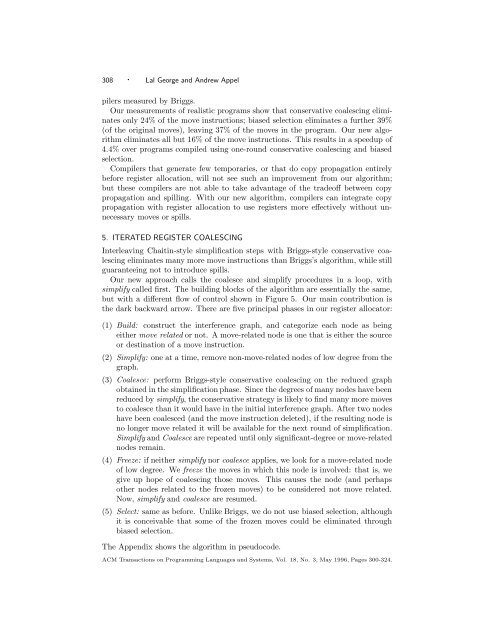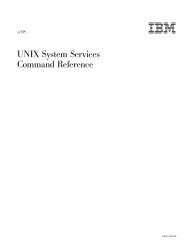Iterated Register Coalescing - School of Computer Science
Iterated Register Coalescing - School of Computer Science
Iterated Register Coalescing - School of Computer Science
Create successful ePaper yourself
Turn your PDF publications into a flip-book with our unique Google optimized e-Paper software.
308 · Lal George and Andrew Appelpilers measured by Briggs.Our measurements <strong>of</strong> realistic programs show that conservative coalescing eliminatesonly 24% <strong>of</strong> the move instructions; biased selection eliminates a further 39%(<strong>of</strong> the original moves), leaving 37% <strong>of</strong> the moves in the program. Our new algorithmeliminates all but 16% <strong>of</strong> the move instructions. This results in a speedup <strong>of</strong>4.4% over programs compiled using one-round conservative coalescing and biasedselection.Compilers that generate few temporaries, or that do copy propagation entirelybefore register allocation, will not see such an improvement from our algorithm;but these compilers are not able to take advantage <strong>of</strong> the trade<strong>of</strong>f between copypropagation and spilling. With our new algorithm, compilers can integrate copypropagation with register allocation to use registers more effectively without unnecessarymoves or spills.5. ITERATED REGISTER COALESCINGInterleaving Chaitin-style simplification steps with Briggs-style conservative coalescingeliminates many more move instructions than Briggs’s algorithm, while stillguaranteeing not to introduce spills.Our new approach calls the coalesce and simplify procedures in a loop, withsimplify called first. The building blocks <strong>of</strong> the algorithm are essentially the same,but with a different flow <strong>of</strong> control shown in Figure 5. Our main contribution isthe dark backward arrow. There are five principal phases in our register allocator:(1) Build: construct the interference graph, and categorize each node as beingeither move related or not. A move-related node is one that is either the sourceor destination <strong>of</strong> a move instruction.(2) Simplify: one at a time, remove non-move-related nodes <strong>of</strong> low degree from thegraph.(3) Coalesce: perform Briggs-style conservative coalescing on the reduced graphobtained in the simplification phase. Since the degrees <strong>of</strong> many nodes have beenreduced by simplify, the conservative strategy is likely to find many more movesto coalesce than it would have in the initial interference graph. After two nodeshave been coalesced (and the move instruction deleted), if the resulting node isno longer move related it will be available for the next round <strong>of</strong> simplification.Simplify and Coalesce are repeated until only significant-degree or move-relatednodes remain.(4) Freeze: if neither simplify nor coalesce applies, we look for a move-related node<strong>of</strong> low degree. We freeze the moves in which this node is involved: that is, wegive up hope <strong>of</strong> coalescing those moves. This causes the node (and perhapsother nodes related to the frozen moves) to be considered not move related.Now, simplify and coalesce are resumed.(5) Select: same as before. Unlike Briggs, we do not use biased selection, althoughit is conceivable that some <strong>of</strong> the frozen moves could be eliminated throughbiased selection.The Appendix shows the algorithm in pseudocode.ACM Transactions on Programming Languages and Systems, Vol. 18, No. 3, May 1996, Pages 300-324.









